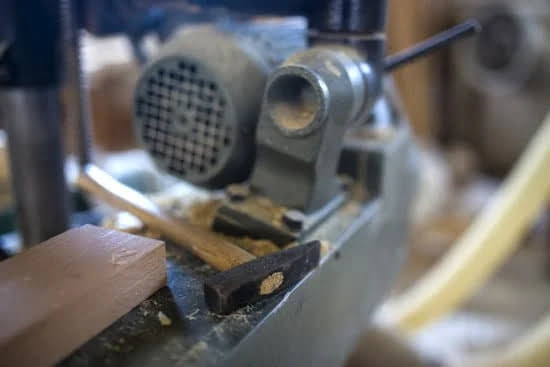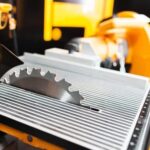Setting Up A Hand Tool Woodworking Shop
There are many things to consider when setting up a hand tool woodworking shop. The most important is the layout of the shop. The layout will determine how you use your space and how efficient you can be.
The first step is to decide where to put your workbench. The workbench should be in a central location in the shop. It should be big enough to accommodate your tools and projects. It should also be sturdy enough to withstand the rigors of woodworking.
The next step is to determine the layout of your shop. The layout should be designed to make the most efficient use of your space. You should consider the location of your tools and the flow of traffic in the shop.
The final step is to stock your shop with the tools and supplies you need. You should start with the basic tools and add to your collection as you need them. Be sure to stock up on woodworking supplies, including lumber, clamps, and sandpaper.
Traditional Woodworking Hand Tools
There’s something special about hand tools.
Maybe it’s the feel of the wood in your hands as you plane it smooth. Maybe it’s the satisfaction of seeing your work take shape before your eyes. Or maybe it’s just the old-fashioned charm of using tools that our ancestors used for centuries.
Whatever the reason, there’s no denying that hand tools have a special appeal. And if you’re looking for a way to add a touch of hand-crafted elegance to your woodworking projects, then traditional woodworking hand tools are the way to go.
At their core, traditional woodworking hand tools are simple and elegant. They’re designed to help you achieve the perfect finished product, with as little fuss as possible.
There are a variety of different hand tools available, each with its own set of unique benefits. Here are just a few of the most popular hand tools for traditional woodworking:
Chisels
Chisels are probably the most fundamental of all woodworking hand tools. They’re used for everything from rough shaping to fine detail work. Chisels come in a variety of shapes and sizes, so it’s important to choose the right one for the task at hand.
Bench Chisels are the most common type of chisel. They have a straight blade and a comfortable handle. They’re perfect for general purpose use.
Fishtail Chisels have a curved blade that’s perfect for detailed work.
Paring Chisels are small and delicate, perfect for working in tight spaces.
Hammer
A hammer is an essential tool for traditional woodworking. It’s used for everything from driving nails to shaping wood. There are a variety of different hammers available, each with its own set of unique benefits.
The most common type of hammer is the Claw Hammer. It has a curved claw on one end that’s perfect for pulling nails.
The Ball Peen Hammer is perfect for shaping metal.
The Sledge Hammer is perfect for heavy-duty tasks like breaking up concrete.
Rasp
A rasp is a type of file that’s perfect for shaping wood. It has a rough surface that’s perfect for removing material quickly. Rasp come in a variety of different shapes and sizes, so it’s important to choose the right one for the task at hand.
The Flat File is the most common type of rasp. It has a flat surface that’s perfect for general purpose use.
The Half Round File is perfect for curved surfaces.
The Round File is perfect for shaping circular shapes.
The Triangular File is perfect for tight spaces.
Saw
A saw is a tool that’s used for cutting wood. There are a variety of different saws available, each with its own set of unique benefits.
The most common type of saw is the Hand Saw. It has a straight blade and a comfortable handle. It’s perfect for general purpose use.
The Cross Cut Saw is perfect for cutting across the grain of the wood.
The Rip Cut Saw is perfect for cutting with the grain of the wood.
The Coping Saw is perfect for cutting curved shapes.
The Jigsaw is perfect for cutting intricate shapes.
Plane
A plane is a tool that’s used for smoothing wood. It has a flat blade that’s perfect for removing material quickly. Plane come in a variety of different shapes and sizes, so it’s important to choose the right one for the task at hand.
The most common type of plane is the Bench Plane. It has a flat blade and a comfortable handle. It’s perfect for general purpose use.
The Block Plane is perfect for small, detailed work.
The Edge Plane is perfect for smoothing the edge of a piece of wood.
The Dovetail Plane is perfect for shaping dovetail joints.
The Chisel Plane is perfect for shaping chisels.
The Marking Gauge
A marking gauge is a tool that’s used for marking lines on wood. It has a sharp blade that’s perfect for making quick, accurate marks. Marking gauges come in a variety of different shapes and sizes, so it’s important to choose the right one for the task at hand.
The most common type of marking gauge is the Mortise Gauge. It has a long, adjustable blade that’s perfect for marking mortise holes.
The Tenon Gauge is perfect for marking tenon joints.
The Divider is perfect for dividing a piece of wood into equal parts.
The Bevel Gauge is perfect for marking angles.
The Try Square
A try square is a tool that’s used for checking the accuracy of square joints. It has a sharp blade that’s perfect for making quick, accurate marks. Try squares come in a variety of different shapes and sizes, so it’s important to choose the right one for the task at hand.
The most common type of try square is the Carpenter’s Square. It has a long, adjustable blade that’s perfect for checking the accuracy of square joints.
The Engineering Square is perfect for checking the accuracy of angles.
The Speed Square is perfect for quickly checking the accuracy of 90 degree angles.
Hitachi Woodworking Tools
has a blog!
That’s right, we have a blog and it is full of interesting and helpful information about woodworking tools, techniques, and projects.
Our blog is a great resource for woodworkers of all skill levels. We have posts about the latest tool technology, how-to guides for specific projects, and expert advice from our team of woodworking experts.
We also have a section of our blog where we feature customer projects. This is a great way to get inspired and see how other woodworkers are using our tools to create amazing pieces of furniture and décor.
So whether you are a beginner just starting out in the world of woodworking or an experienced craftsman looking for new ideas and tips, be sure to check out our blog. We promise you won’t be disappointed!
Old Woodworking Hand Tools
There is something special about old woodworking hand tools. Maybe it’s the history, or the craftsmanship, or the way they just feel in your hand. Whatever it is, there’s just something about them that can’t be matched by modern tools.
If you’re interested in woodworking, it’s important to learn about and use old woodworking hand tools. Here are a few of the most common ones:
Chisels – Chisels are used for cutting and shaping wood. There are many different types of chisels, but all of them are designed to provide a sharp, precise edge.
– Chisels are used for cutting and shaping wood. There are many different types of chisels, but all of them are designed to provide a sharp, precise edge. Gouges – Gouges are similar to chisels, but they are designed for cutting curved shapes in wood. Gouges come in a variety of shapes and sizes, so you can choose the one that best suits your needs.
– Gouges are similar to chisels, but they are designed for cutting curved shapes in wood. Gouges come in a variety of shapes and sizes, so you can choose the one that best suits your needs. Planes – Planes are used to create a smooth surface on wood. There are many different types of planes, each with its own set of unique features.
– Planes are used to create a smooth surface on wood. There are many different types of planes, each with its own set of unique features. Saw – A saw is a tool used for cutting wood. There are many different types of saws, each with its own unique set of features.
– A saw is a tool used for cutting wood. There are many different types of saws, each with its own unique set of features. Hammers – Hammers are used for pounding nails into wood. There are many different types of hammers, each with its own unique set of features.
– Hammers are used for pounding nails into wood. There are many different types of hammers, each with its own unique set of features. Chisels – Chisels are used for cutting and shaping wood. There are many different types of chisels, but all of them are designed to provide a sharp, precise edge.
– Chisels are used for cutting and shaping wood. There are many different types of chisels, but all of them are designed to provide a sharp, precise edge. Gouges – Gouges are similar to chisels, but they are designed for cutting curved shapes in wood. Gouges come in a variety of shapes and sizes, so you can choose the one that best suits your needs.
– Gouges are similar to chisels, but they are designed for cutting curved shapes in wood. Gouges come in a variety of shapes and sizes, so you can choose the one that best suits your needs. Planes – Planes are used to create a smooth surface on wood. There are many different types of planes, each with its own set of unique features.
– Planes are used to create a smooth surface on wood. There are many different types of planes, each with its own set of unique features. Saw – A saw is a tool used for cutting wood. There are many different types of saws, each with its own unique set of features.
– A saw is a tool used for cutting wood. There are many different types of saws, each with its own unique set of features. Hammers – Hammers are used for pounding nails into wood. There are many different types of hammers, each with its own unique set of features.
When choosing old woodworking hand tools, it’s important to keep in mind the specific tasks you’ll be using them for. Each tool has its own strengths and weaknesses, so it’s important to select the right tool for the job.
With old woodworking hand tools, you’ll be able to create beautiful pieces of furniture that will last for generations.
Woodworking Tool Show
case:
There are many woodworking tools on the market, and it can be difficult to know which ones are the best for your needs. In this article, we will take a look at some of the most popular woodworking tools and discuss their features and benefits.
First, we will look at the table saw. The table saw is a key piece of equipment for any woodworker, and it is used to make a variety of cuts, including crosscuts and rip cuts. It is important to choose a table saw that is powerful enough to handle the tasks you need it to, but not so powerful that it is difficult to control. The table saws on the market today range in power from around 1 to 5 horsepower, so you should be able to find one that meets your needs.
Another important consideration when choosing a table saw is the size of the table. The table should be large enough to accommodate the workpieces you will be cutting, and it should also have a miter slot to allow you to make angled cuts.
In addition to the table saw, there are a number of other important woodworking tools. The miter saw is used to make precise crosscuts, and it is a key tool for making crown molding and other intricate cuts. The drill press is used to drill holes in wood, and the power saw is used to cut through large pieces of wood.
The woodworking tools on the market today are powerful and versatile, and they can help you complete a wide variety of tasks. be sure to choose the tools that are right for your needs, and you will be able to accomplish a wide range of projects.

Hi everyone! I’m a woodworker and blogger, and this is my woodworking blog. In my blog, I share tips and tricks for woodworkers of all skill levels, as well as project ideas that you can try yourself.





